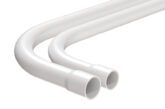
Jake Green, Head of Technical Engagement with Scolmore Group, considers the necessity of maintaining signal integrity for life safety services such as fire alarm systems and emergency lighting systems.
In any electrical installation, it is necessary to give adequate support to cables. The reasons for this are twofold:
- Maintenance of the signal pathway
- Reduce the risk of premature collapse to protect firefighters accessing a premises during fire.
Three specific life safety standards to be considered are:
- BS5266-1: 2016 Emergency lighting – Part 1: Code of practice for the emergency lighting of premises;
- BS5839-1: 2017 Fire detection and fire alarm systems for buildings Part 1: Code of practice for design, installation, commissioning and maintenance of systems in non-domestic premises; and
- BS8519: 2020 Selection and installation of fire-resistant power and control cable systems for life safety, fire-fighting and other critical applications – Code of practice.
Other relevant references will be made to the requirements of BS7671: 2018 Amd 2: Requirements for Electrical Installations.
Emergency lighting
Emergency lighting systems require installed cables to be able to withstand the effects of fire as well as remain in-situ for a period necessary to ensure safe egress of persons. To address these issues, Clause 8 of BS5266-1 covers wiring systems and circuits in general.
For self-contained emergency luminaires, there is no recommendation for fire-protected cables (clause 8.1), and the general requirements of BS7671 will apply. These include the need to support the wiring system in such a way that it is not liable to premature collapse (521.10.202).
However, where the emergency lighting system consists of a central battery, it is of critical importance that the quality of the installation, the fire-integrity of the cables and their supports is maintained. The risk of a loss of signal, and hence illuminance, is increased where poor installation practices are carried out (Note 1 Clause 8.2.1).
Clause 8.22 of BS5266-1 details the nature of cable types recognised as being acceptable. This clause details minimum cable survival times ranging from 60 minutes to 120 minutes.
Without suitable survival times for the support of such cables, it will be impossible to ensure circuit integrity. The methods of cable support and fixings should be non-combustible and such that circuit integrity will not be reduced below that afforded by the cable used (Clause 8.2.3). This means, for example, that where a cable is rated as ‘enhanced emergency lighting cables with inherently high resistance to attach by fire’, the support means should also be capable of performing its function for 120 minutes.
Furthermore, where cable management system support is provided by drop rods, the drop rod size should be calculated in accordance with the recommendations of BS8519.
Fire detection and fire alarm systems
The commentary to clause 26 of BS5839-1 recognises that all interconnections must operate correctly at the time of a fire. Clause 26.2 recommends that cables forming part of the critical path conform to certain standards. These include mineral insulated copper sheathed cables, cables conforming to BS7629-1, and the like.
Like the recommendations of BS5266-1, clause 26.2f) of BS5839-1 recommends that methods of cable support should be non-combustible and such that circuit integrity is not reduced below that afforded by the cable used, and that they should be able to withstand a similar temperature to that of the cable being supported. This recommendation, in effect, precludes the use of plastic cable clips, ties and trunking as means of cable support.
Fire-resistant power and control cable systems
As with both emergency lighting systems and fire detection and fire alarm systems, BS8519: 2020 addresses the need to ensure cable support systems are adequate to meet the fire survival times of the cables they support.
The recommendations found in BS8519 are like those detailed in both BS5266-1 and BS5839-1. However, additional guidance is provided where a bracket and rod system is used to support safety critical cable systems. Clause 16 of BS8519 recognises that the strength of steel is adversely affected by fire such that great care should be taken in determining the cross-sectional area of the steel rod drops.
Conclusion
It is essential that great care is taken when installing cables supplying life safety systems, such as fire detection and fire alarm systems, emergency lighting systems and fire-fighting lifts. The installer must use appropriate cables and support systems to ensure that critical systems continue to function during fire.
Find out more here










